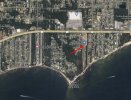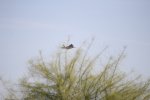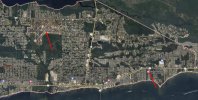Not at all, I live on the mainland side in Navarre. I'm very well aware of the restricted airspaces around here, but not where I live, at least I've looked several times (B4UFLY, etc) and where I am there are no restrictions. And, no, these are not any type of military aircraft, of course it would be different if they were. These are small Cessna-like aircraft with no special markings to identify them as anything else than private or commercial small aircraft.
You are using an out of date browser. It may not display this or other websites correctly.
You should upgrade or use an alternative browser.
You should upgrade or use an alternative browser.
What Can I do?
- Thread starter drone_dh
- Start date
B4YouFly is no longer supported. It's been replaced by four FAA-sanctioned commercial apps that provide the same services.@MS Coast I am looking at your website, and trying to figure out just exactly where I'm at on this map.
Is B4UFLY not a reliable thing now?
The online sectional viewer can be a bit slow on some connections. You can zoom in for a better look, but one of the B4YouFly replacements will probably be easier to use for drone flights.
You may be adjacent to one of the two airfields in Navarre. The largest is the Holly NOLF (Navy out-lying field). It's marked as closed but they may be doing practice approaches to it. Another possibility is the Fort Walton Beach Airfield on the east end of town. It's active and if you're just north of it, you may be seeing some very low aircraft landing or departing.
Aircraft shooting approaches to either location could be pulling the throttle back over houses close to the runways. They wouldn't be practicing stalls in the area.



Thanks for the help/clarification. Especially the fact that B4UFLY isn't supported. Wow, that is news. I guess I need to get more informed, as always. The NOLF airfield is the one that is now covered in solar panels, but if they were practicing things I suppose that would explain a lot. It is the closest to me, I'm to the south and west of it.
Ahhhhh...that's what I remember from ground school! Given this, however, "what if" the drone pilot was flying @or< 400AGL and a manned aircraft were to violate the 500AGL and they collided with both craft crashing. What might be the expected outcome/findings re: the incident? Based on other entries here, I get the impression that the drone pilot would be at fault, no matter what was occurring?Here's what you wanted:
§ 91.119 Minimum safe altitudes: General.
Except when necessary for takeoff or landing, no person may operate an aircraft below the following altitudes:
(a) Anywhere. An altitude allowing, if a power unit fails, an emergency landing without undue hazard to persons or property on the surface.
(b) Over congested areas. Over any congested area of a city, town, or settlement, or over any open air assembly of persons, an altitude of 1,000 feet above the highest obstacle within a horizontal radius of 2,000 feet of the aircraft.
(c) Over other than congested areas. An altitude of 500 feet above the surface, except over open water or sparsely populated areas. In those cases, the aircraft may not be operated closer than 500 feet to any person, vessel, vehicle, or structure.
(d) Helicopters, powered parachutes, and weight-shift-control aircraft. If the operation is conducted without hazard to persons or property on the surface—
(1) A helicopter may be operated at less than the minimums prescribed in paragraph (b) or (c) of this section, provided each person operating the helicopter complies with any routes or altitudes specifically prescribed for helicopters by the FAA
If the wind was northerly, they'd be descending in the direction shown by the red arrows and would be quite low near those houses.Thanks for the help/clarification. Especially the fact that B4UFLY isn't supported. Wow, that is news. I guess I need to get more informed, as always. The NOLF airfield is the one that is now covered in solar panels, but if they were practicing things I suppose that would explain a lot. It is the closest to me, I'm to the south and west of it.
(That should be Holley NOLF, rather than Holly. My mistake.)
DARKSeifer
Well-Known Member
Planes usually seem lower than they actually are, and usually seem above while they aren't due to size and perspective.
Same for drones, but on a smaller scale, it's full of karens around claiming the drone is "above their property" while it's at 200m or more.
Worst case scenario, planets align and the plane you say it's flying too low collides with your drone, it would be your fault, because you need to move the drone away if any manned aircraft is nearby, no matter what the manned aircraft is doing or what rules he is infringing, he has preference. You lose your drone, the plane gets a dent on the prop or the wing, you just buy another second hand unit, and problem solved.
The likelihood of that to happen is really low, lower than winning the lottery.
Same for drones, but on a smaller scale, it's full of karens around claiming the drone is "above their property" while it's at 200m or more.
Worst case scenario, planets align and the plane you say it's flying too low collides with your drone, it would be your fault, because you need to move the drone away if any manned aircraft is nearby, no matter what the manned aircraft is doing or what rules he is infringing, he has preference. You lose your drone, the plane gets a dent on the prop or the wing, you just buy another second hand unit, and problem solved.
The likelihood of that to happen is really low, lower than winning the lottery.
Yes, the drone pilot is obligated to give way to all other traffic.Ahhhhh...that's what I remember from ground school! Given this, however, "what if" the drone pilot was flying @or< 400AGL and a manned aircraft were to violate the 500AGL and they collided with both craft crashing. What might be the expected outcome/findings re: the incident? Based on other entries here, I get the impression that the drone pilot would be at fault, no matter what was occurring?
Droning on and on...
Well-Known Member
I saw a helicopter flying over our local small town about 150' AGL, perhaps even lower than that. Just a bit above the treetops.
Just seemed grossly irresponsible to me. Forget about drones, just way too many things can go wrong that close to the ground.
Not really.
Helicopters are far more maneuverable, and can stop in place and hover. The safety concerns at low altitude are far less, and they have different rules at low altitude than fixed wing aircraft because of it.
Droning on and on...
Well-Known Member
The Florida Panhandle has many USN and USAF flight training and operations areas. Are the aircraft you're seeing military?
Regardless, these training airspaces do not include 400' over residential neighborhoods, I'm 100% certain.
Droning on and on...
Well-Known Member
Yes, the drone pilot is obligated to give way to all other traffic.
Absolutely... the drone pilot is in no danger.
Daytona500
Well-Known Member
Well my problem is low flying Military jets, f-35,F-18 ect ect. I live about 40 miles from LAFB and they fly missions over my house on occasion, you never know when, some times 2 or 3 time a week then nothing for weeks. B ecause they come up over the Mtn to the west which is about a mile from me then drop down low ,and there coming in at 4 to 500 mph. you don't here them till they clear the mtn then its like 2 seconds till there over me. if I'm at 400 ft I have zero time to drop down.Not a lot I can do except Pray,

Over a built up area there are two bits of legislation ! One 1000 feet above the highest point in tha built up area ! We usually use 1500 feet as a coverall to cross towns etc but 2 iis the glide clear rule which means that a single engined aircraft losing an engine has to be at a heigjt where they can glad clear which might be much higher that the 1000 or 1500 feet !Because I routinely fly my drones to just below 400 feet above my house to see what the beach looks like. I am less than half a mile from the beach, and whether anyone wants to contest my judgement, they ARE flying, and doing stalls, much, much lower than 1500, and the guy yesterday prompting my post was DEFINITELY less than 400. I was in the yard planting with my wife, and the plane, which was close enough I could see the pilot's face, cut his engine just above my house. Sorry guys, I ain't makin it up. I just wanted to know if they should be doing this, and what should I do to keep them from doing it, if possible. Also, the question came up am I on an approach to an airport - absolutely not! There used to be a small airport about 5 or so miles away but they filled the entire thing up with solar panels, and it is no longer useable as an airfield.
So, many flights above my house is how a drone pilot can determine, at least fairly closely, how far above my head an aircraft is.
outside of built up areas 500 feet is the minimum other than for landing or takeoffs and this could include practice forced landings into a field where the pilot might descent far enough to where the instructor is happy the pilot would make it and then they go around !
No pilot would practice stalls low level as that would be suicide .
Military have training zones where they will fly low level ar 200 feet
Would be interesting to know your rough location
I didn't ask questions here to completely ignore you all. I'm just going to assume that I do not guage the height of the aircraft properly, and I definitely need to get a replacement for B4UFLY! Thanks to all, the next time I look up and see a plane right over my house I guess I'll just have another shot of good tequila and call it good, lol!
That's how I understand it also 500 ft...only exception would be in case of some emergency situation. Still, it is the drone operator responsibility of keeping visual line of sight (VLOS), or an observer, and taking caution when manned aircraft is near by.As has been said above, the onus is on you to look and listen and yield to manned aircraft. As far as I'm aware, fixed wing aircraft must stay above 500ft unless on final for landing or checking out a landing field. Are you on the approach to an airfield? If it's an small airfield it won't necessarily be in controlled airspace.
If fixed wing planes are buzzing your house that low and you're not on a runway approach you could/should contact the FAA.
I'll stand corrected if any pilots want to jump in here.
But I'm confused? If the manned aircraft is violating FAA regs, and the drone pilot is at fault regardless, what is the point of having any regulations? That seems like saying if someone is robbing a bank, and is injured in the process, the robber is going to win the law suit for those injuries, against the bank for his/her injuries? I mean, if the manned aircraft was NOT breaking the law in the first place, the incident wouldn't have even happened? This reminds me of a situation I was in...I was a beekeeper. I was informed my my insurance carrier that it wasn't a matter of if I'd be sued, but when! Even though my apiary was on posted private property, people would trespass onto that property, exposing themselves to millions of stinging insects, and when they got stung, I would be held liable, even though they were ignoring all warnings/signage, and trespassing, thereby actually causing the incident!!!! Just gotta love America's legal system?Yes, the drone pilot is obligated to give way to all other traffic.
The drone pilot is at fault. What happens after that is debatable. You may or may not win a lawsuit, you may or may not receive a penalty. The FAA puts the responsibility on the drone pilot and may or may not explain it, support it, reverse it, etc from there. What this means is as a drone pilot, you can expect to start the process by taking the full blame for any accident and then you can work it from there. Good luck!But I'm confused? If the manned aircraft is violating FAA regs, and the drone pilot is at fault regardless, what is the point of having any regulations? That seems like saying if someone is robbing a bank, and is injured in the process, the robber is going to win the law suit for those injuries, against the bank for his/her injuries? I mean, if the manned aircraft was NOT breaking the law in the first place, the incident wouldn't have even happened? This reminds me of a situation I was in...I was a beekeeper. I was informed my my insurance carrier that it wasn't a matter of if I'd be sued, but when! Even though my apiary was on posted private property, people would trespass onto that property, exposing themselves to millions of stinging insects, and when they got stung, I would be held liable, even though they were ignoring all warnings/signage, and trespassing, thereby actually causing the incident!!!! Just gotta love America's legal system?
Droning on and on...
Well-Known Member
But I'm confused? If the manned aircraft is violating FAA regs, and the drone pilot is at fault regardless, what is the point of having any regulations?
You're not accounting for two very important differences: The manned aircraft has lives at risk, you don't. Second, your drone is far more maneuverable than the airplane, and can much more easily get out of the way.
The fact the manned craft (may) be violating other regs is irrelevant to whether or not you must follow them. Those drone regulations are there for a good reason – the safety of people flying – and those reasons don't go away just because the plane is violating something.
Would you argue your obligation to avoid a collision with a manned aircraft is relieved because the pilot didn't follow regulations and allowed his ticket to expire the day before, and is illegally flying today?
hank970
Well-Known Member
If a plane is flying below minimums over a developed area, you should try to get a photograph of it and its tail number. Ideally, such a photo would also include one or more fixed visual references, such as rooftops, trees, or utility poles, which would provide a sense of scale and help illustrate how low the plane is flying.
In another life, as a national park ranger long, long ago, I observed a plane repeatedly hazing a herd of bison in the North Unit of Theodore Roosevelt NP. I didn't have a camera or binoculars with me at the time but the plane was low enough that I could easily read its tail number. I furnished the FAA with the plane's tail number, and the FAA gave me the name of the aircraft owner. I cited the owner/pilot, and he was convicted in federal magistrate's court and fined. I don't know if the FAA penalized him further.
The federal magistrate, incidentally, was an Air Force Academy graduate, but not a pilot. He'd gone on to law school and served in the JAG.
In another life, as a national park ranger long, long ago, I observed a plane repeatedly hazing a herd of bison in the North Unit of Theodore Roosevelt NP. I didn't have a camera or binoculars with me at the time but the plane was low enough that I could easily read its tail number. I furnished the FAA with the plane's tail number, and the FAA gave me the name of the aircraft owner. I cited the owner/pilot, and he was convicted in federal magistrate's court and fined. I don't know if the FAA penalized him further.
The federal magistrate, incidentally, was an Air Force Academy graduate, but not a pilot. He'd gone on to law school and served in the JAG.
Similar threads
- Replies
- 37
- Views
- 4K
- Replies
- 44
- Views
- 4K
- Replies
- 80
- Views
- 3K
- Replies
- 30
- Views
- 2K
DJI Drone Deals
New Threads
-
-
Mini 5 Pro Drone generated pano (21 images) vs Photoshop Pano (21 images)
- Started by Dale D
- Replies: 1
-
-
Panorama question - how do I process 11 and 21 and greater images?
- Started by Dale D
- Replies: 7
-










